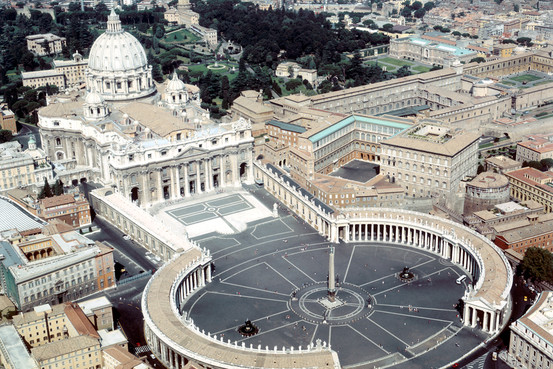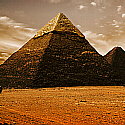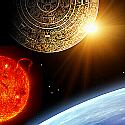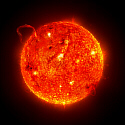Seed Struggle & Alien Savior
NOTE: If you don’t have a copy of Tom Horn’s “Exo Vaticana”, you need to add it to your library. It is an essential read for those wanting to understand the deception that is coming and how believers need to prepare for it.
By Tom Horn & Chris Putnam
RaidersNewsUpdate.com
We’ve discussed how all of the Bible is really a story about the ancient and future struggle between the “seed” of the woman (Jesus) and that of the serpent. The connection between the coming clash between these “seeds” and emerging Catholic exo-theology will shock most, as it directly involves the arrival of serpent-saviors and the birth of Apollo (a.k.a. Osiris) from “the promised seed” of the novus ordo seclorum prophecy on the Great Seal of the United States.
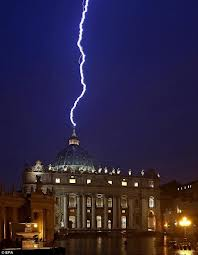 How could the Vatican be associated with the pagan prophecy on the Great Seal of the United States, you ask? The lightning that struck St. Peter’s Basillica immediately following Pope Benedicts’ resignation points the way, but more on that in a moment.
How could the Vatican be associated with the pagan prophecy on the Great Seal of the United States, you ask? The lightning that struck St. Peter’s Basillica immediately following Pope Benedicts’ resignation points the way, but more on that in a moment.
First, understand the deeply occultic and important role the three-hundred-thirty ton Obelisk in St. Peter’s Square in the Vatican City was designed to play. It is not just any Obelisk but one that was cut from a single block of red granite during the Fifth dynasty of Egypt to stand as Osiris’ (a.k.a. Apollo’s) erect phallus at the Temple of the Sun in ancient Heliopolis (Ἡλιούπολις, meaning city of the sun or principal seat of Atum-Ra sun-worship), the city of “On” in the Bible, dedicated to Ra, Osiris, and Isis.
The Obelisk was moved from Heliopolis to the Julian Forum of Alexandria by Emperor Augustus and later from thence (approximately 37 AD) by Caligula to Rome to stand at the spine of the Circus. There, under Nero, its excited presence maintained a counter-vigil over countless brutal Christian executions, including the martyrdom of the apostle Peter (according to some historians). Over fifteen hundred years following that, Pope Sixtus V ordered hundreds of workmen under celebrated engineer-architects Giovanni and Domenico Fontana to move the phallic pillar to the center of St. Peter’s Square in Rome. This proved a daunting task, which took over four months, nine hundred laborers, one hundred forty horses, and seventy winches.
Though worshipped at its present location ever since by countless admirers, the proximity of the Obelisk to the old Basilica was formerly “resented as something of a provocation, almost as a slight to the Christian religion. It had stood there like a false idol, as it were vaingloriously, on what was believed to be the center of the accursed circus where the early Christians and St. Peter had been put to death. Its sides, then as now, were graven with dedications to [the worst of ruthless pagans] Augustus and Tiberius.”
The fact that many traditional Catholics as well as Protestants perceived such idols of stone to be not only objects of heathen adoration but the worship of demons (see Acts 7:41–42; Psalms 96:5; and 1 Corinthians 10:20) makes what motivated Pope Sixtus to erect the phallus of Osiris in the heart of St. Peter’s Square, located in Vatican City and bordering St. Peter’s Basilica where prophetic lightning struck it twice last week, very curious.
To ancient Christians, the image of a cross and symbol of Jesus sitting atop (or emitting from) the head of a demonic god’s erect manhood would have been at a minimum a very serious blasphemy. Yet Sixtus was not content with simply restoring and using such ancient pagan relics (which were believed in those days to actually house the pagan spirit they represented) but even destroyed Christian artifacts in the process.
Michael W. Cole, Associate Professor in the Department of the History of Art at the University of Pennsylvania, and Professor Rebecca E. Zorach, Associate Professor of Art History at the University of Chicago, raise critical questions about this in their scholarly book The Idol in the Age of Art when they state:
Whereas Gregory, to follow the chroniclers, had ritually dismembered the city’s imagines daemonem [demonic images], Sixtus fixed what was in disrepair, added missing parts, and made the “idols” into prominent urban features. Two of the four obelisks had to be reconstructed from found or excavated pieces… The pope was even content to destroy Christian antiquities in the process: as Jennifer Montagu has pointed out, the bronze for the statues of Peter and Paul came from the medieval doors of S. Agnese, from the Scala Santa at the Lateran, and from a ciborium at St. Peter’s.
[Sixtus] must have realized that, especially in their work on the two [broken obelisks], they were not merely repairing injured objects, but also restoring a type… In his classic book The Gothic Idol, Michael Camille showed literally dozens of medieval images in which the freestanding figure atop a column betokened the pagan idol. The sheer quantity of Camille’s examples makes it clear that the device, and what it stood for, would have been immediately recognizable to medieval viewers, and there is no reason to assume that, by Sixtus’s time, this had ceased to be true.
The important point made by Professors Cole and Zorach is that at the time Sixtus was busy reintroducing to the Roman public square restored images and statues on columns, the belief remained strong that these idols housed their patron deity, and further that, if these were not treated properly and even placed into service during proper constellations related to their myth, it could beckon evil omens, such as lightning. Most people including even perhaps Pope Benedict himself, were blissfully unaware of the ancient signature last week’s dual strikes atop St. Peter’s Basilica represented, especially as it involves the looming papal inauguration of Petrus Romanus.
For a few adepts of history and secret orders, the sign from heaven was deliciously staged. The term “inaugurate” is from the Latin “inauguratio,” and refers to the archaic ceremony by which the Roman augurs (soothsayers) approved a king or ruler (or other action) through omens as being “sanctioned by the gods.” As for Petrus Romanus, his “inauguration” was sealed by the same omen the ancient augurs used in determining the will of the gods for a king—thunder and lightning as the most important auspice and sign that Jupiter—the father of Apollo—was watching.
There is strong indication that Pope Sixtus not only believed in such omens but that he “worried about the powers that might inhabit his new urban markers.”[iii] This was clearly evident when the cross was placed on top of the Obelisk in the midst of St. Peter’s Square and the pope marked the occasion by conducting the ancient rite of exorcism against the phallic symbol. First scheduled to occur on September 14th to coincide with the liturgical Feast of the Exaltation of the Cross and not coincidently under the zodiacal sign of Virgo (Isis), the event was delayed until later in the month and fell under the sign of Libra, representing a zenith event for the year.
On that morning, a pontifical High Mass was held just before the cross was raised from a portable altar to the apex of Baal’s Shaft (as such phallic towers were also known). While clergy prayed and a choir sang Psalms, Pope Sixtus stood facing the Obelisk and, extending his hand toward it, announced: “Exorcizote, creatura lapidis, in nomine Dei” (“I exorcize you, creature of stone, in the name of God”). Sixtus then cast sanctified water upon the pillar’s middle, then its right side, then left, then above, and finally below to form a cross, followed by, “In nomine Patris, et Filij, et Spiritus sancti. Amen” (“In the Name of the Father and of the Son and of the Holy Ghost. Amen”). He then crossed himself three times and watched as the symbol of Christ was placed atop Osiris’ erect phallus.
Yet if what Sixtus established in the heart of Vatican City gives some readers pause (numerous other signature events by Sixtus aligned the Sistine city with constellations sacred to Osiris and Isis, which we are not taking time to discuss here but that caused Profs. Zorach and Cole to conclude that, in the end, Sixtus wanted to remain in the good graces of the pagan gods), in Washington, DC near the west end of the National Mall, the Obelisk built by Freemasons and dedicated to America’s first president brings the fullest meaning to the nephilim-originated and modern porn-industry impression that “size matters.” This is no crude declaration, as adepts of ritual sex-magic know, and dates back to ancient women who wanted to give birth to the offspring of the gods and who judged the size of the male generative organ as indicative of the “giant” genetics or divine seed needed for such offspring. While such phallic symbols have been and still are found in cultures around the world, in ancient Egypt, devotion to this type “obscene divinity” began with Amun-Min and reached its crescendo in the Obelisks of Osiris.
Throughout Greece and Rome the god Priapus (son of Aphrodite) was invoked as a symbol of such divine fertility and later became directly linked to the cult of pornography reflected in the more modern sentiments about “size.” This is important because, in addition to the Washington Monument being intentionally constructed to be the tallest Obelisk of its kind in the world at 6,666 (some say 6,660) inches high and 666 inches wide along each side at the base, one of the original concepts for the Washington Monument included Apollo (the Greek version of Osiris) triumphantly returning in his heavenly chariot, and another illustrating a tower “like that of Babel” for its head.
Any of these designs would have been equally appropriate to the thirty-three-hundred-pound pyramidal capstone it now displays, as all three concepts carried the meaning necessary to accomplish what late researcher David Flynn described as “the same secret knowledge preserved by the mystery schools since the time of the Pelasgians [that] display modern Isis Osiris worship.”[iv] This is to say, the “seed” discharged from a Tower-of-Babel-shaped head would magically issue forth the same as would proceed from the existing Egyptian capstone—the offspring of Apollo/Osiris/Nimrod.
The greatest minds in Freemasonry, whose beliefs set the tone for the design of the capital city, its Great Seal, its Dome, and its Obelisk, understood and wrote about this intent. Albert Pike described it as Isis and Osiris’ “Active and Passive Principles of the Universe…commonly symbolized by the generative parts of man and woman,”[v] and Freemason writer Albert Mackey described not only the Obelisk, but added the importance of the circle around its base, saying, “The Phallus was an imitation of the male generative organ. It was represented…by a column [Obelisk] that was surrounded by a circle at the base.”
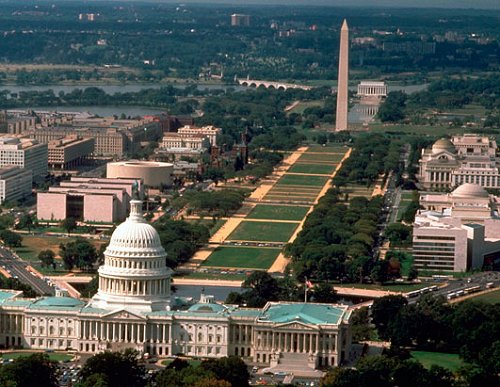
Washington Dome facing Obelisk
In Egypt, where the parodies and rituals for raising Osiris to life through these magical constructs was perfected, Pharaoh served as the “fit extension” for the reborn god to take residence in as the “sex act” was ritualized at the temple of Amun-Ra. The all-seeing eye of Horus/Osiris/Apollo above the unfinished pyramid on the Great Seal forecasts the culmination of this event—that is, the actual return of Osiris—for the United States. This ancient occultism is troubling when harmonized with the two mottoes on the Great Seal—“annuit coeptis” and “novus ordo seclorum”—taken from ancient texts related to the god Apollo. The motto “annuit coeptis” is from Virgil’s Aeneid, in which Ascanius, the son of Aeneas from conquered Troy, prays to Apollo’s father, Jupiter [Zeus] whose thunder and lightning marked Vatican Square on the resignation of Pope Benedict. Charles Thompson, designer of the Great Seal’s final version, condensed line 625 of book IX of Virgil’s Aeneid, which reads, “Juppiter omnipotes, audacibus annue coeptis” [‘All-powerful Jupiter favors (the) daring undertakings’],” to “Annuit coeptis [‘He approves (our) undertakings’].” Was Thompson instructed to do this to conceal the true identity of the “he” of the Great Seal—the mythical father-god Jupiter, who gives Apollo life?
The second and most indisputable authentication that the Great Seal’s symbols and mottoes are in fact a hidden prophesy concerning the return of Apollo is “novus ordo seclorum” (“a new order of the ages”), adapted by Charles Thomson in 1782 when designing the Great Seal. According to the official record, Thomson—a friend of the Masons and great supporter of Benjamin Franklin’s American Philosophical Society—created the phrase from inspiration he found in a prophetic line in Virgil’s Eclogue IV: “Magnus ab integro seclorum nascitur ordo” [Virgil’s Eclogue IV (line 5)], the interpretation of the original Latin being “and the majestic roll of circling centuries begins anew.”
This same Cumaean Sibyl is even prominently featured alongside Old Testament prophets in Michelangelo’s paintings in the Sistine Chapel at the Vatican. Yet upon reading Virgil’s text, it is abundantly clear whom the prophetess of Apollo—directly tied to Washington and the Vatican—was talking about. The divine son, which comes of the Sibyl’s prophecy, is to be spawned of “a new breed of men sent down from heaven” when he receives “the life of gods, and see Heroes with gods commingling.” According to the prophecy, this is Apollo, son of Jupiter (Zeus), who returns to earth through mystical “life” given to him from the gods when the deity returns to reign over the earth in a new golden age.
From the beginning of the prophecy we read:
Now the last age by Cumae’s Sibyl sung Has come and gone, and the majestic roll Of circling centuries begins anew: Justice returns, returns old Saturn’s reign, With a new breed of men sent down from heaven. Only do thou, at the boy’s birth in whom The iron shall cease, the golden race arise, Befriend him, chaste Lucina; ‘tis thine own Apollo reigns.
He shall receive the life of gods, and see Heroes with gods commingling, and himself Be seen of them, and with his father’s worth Reign o’er a world…
Assume thy greatness, for the time draws nigh, Dear child of gods, great progeny of Jove [Jupiter/Zeus]! See how it totters—the world’s orbed might, Earth, and wide ocean, and the vault profound, All, see, enraptured of the coming time!
According to Virgil and the Cumaean Sibyl, whose prophecy formed the novus ordo seclorum of the Great Seal of the United States, the new world order begins during a time of chaos when the earth and oceans are tottering—a time like today. This is when the “son” of promise arrives on earth—Apollo incarnate.
His coming was augured by thunder and lightning just hours after Pope Benedict resigned, and now the Domes and Obelisks at the Vatican and Washington stand ready for the secret, metaphysical ritual to be performed to assure his arrival. We use the phrase “performed in secret” because what the vast majority of people throughout America and Rome do not know is that the “raising” ceremony of Apollo/Osiris is conducted inside the headquarters of the Scottish Rite Freemasonry in the House of the Temple by the Supreme Council 33rd Degree over Washington, DC following the election and inauguration of every American President (just as their Egyptian forefathers did at the temple of Amun-Ra in Karnak) in keeping with the tradition of installing within him the representative spirit of Osiris until such time as the god himself shall fulfill the Great Seal prophecy and return in flesh—in other words, now. The most recent Osiris-endowed US President, Obama, is headed for Israel to announce “peace, peace” at the very same time the College of Cardinals will be assembling in Rome for conclave to elect the prophesied final pope—Petrus Romanus.
Preparing Religious People to Accept the Incarnation of Apollo/Osiris as a Newly Arrived “Alien” Serpent-Savior
Initially, when reading the material above in light of the coded book that Jesuit Guy Consolmagno pointed Tom Horn to, A Case of Conscience, one is tempted to puzzle why a novel written in 1958 furtively touched on (or was guided by a warning or mocking spirit to forecast) how some of Rome’s then-quiet Jesuit astronomers and theologians might later become the ones to argue in favor of what could become end-times deception involving the “fertility” of Satan as an “alien” serpent-savior from the prophesied seed (Apollo/Osiris/Antichrist) of the Evil One.
Upon further contemplation, however, this is really not that astonishing. It was, after all, the Roman Catholic theologians who provided the “liveliest speculation” on the existence and nature of extraterrestrials four years after Blish’s book was printed, when the executive secretary of the American Rocket Society published conjectures on the subject.[vii] Since then, other Vatican authorities have further contended the extraterrestrials might actually express the glory of God better than we humans do, even leading mankind to venerate them as gods, a recurrent theme articulated among numerous Jesuit astronomers. Father Daniel C. Raible thought the eventual acceptance of aliens as objects of worship might naturally occur as a result of them having godlike qualities and preternatural gifts ascribed by humans to divinity:
For example, they might enjoy infused knowledge (they would literally be born with extensive knowledge and would find the acquisition of further knowledge easy and enjoyable); they might be blessed with harmony and concord in the working of their bodily and spiritual faculties; they might be spared the ultimate dissolution of death, passing to their reward at the end of their time of trial as peacefully as the sun sinks below the horizon at the end of the day. They might possess all these preternatural gifts or only some of them in any of various combinations that are limited only by the omnipotence and providence of God.
Father Domenico Grasso not only thought such beings would be “far ahead of us in science and related fields,”[ix] but that their version of salvation might be based on a savior other than Jesus…even a messianic member of their own race. These beings, closer to God than man (perhaps even unfallen), would possess superior theology that could “expand markedly” our terrestrial understanding of redemption and knowledge of God, something current Vatican theologians such as professor of fundamental theology at the Pontificia Università della Santa Croce in Rome [connected with Opus Dei], Giuseppe Tanzella-Nitti, agree with. Another Church scholar, Father Thomas F. O’Meara, a theologian at the University of Notre Dame, imagined these godlike beings spread out across universes “on untold planets called to a special relationship with God” and that “it is a mistake to think that our understanding of ‘covenant,’ the ‘reign of God,’ ‘redemption,’ or ‘shared life’ exhausts the modes by which divine power shares something of its infinite life.”[x] Such Catholic leaders believe these spiritually superior aliens may even have been created by God with the future redemption of humanity in mind—beings who know their place in the eternal scheme of things to evangelize humans when the time is right.
This disturbing and potentially prophetic belief is partially based on theological arguments made by such priests as Monsignor Januaris De Concilio, professor of theology at Immaculate Seminary in New Jersey, who believed “that the immense distance in intellect between human beings and the angels suggest that God would create intermediate species to fill in the gap, and these species would be ETI [Extraterrestrial Intelligence].”
Monsignor Corrado Balducci (who during his life was the official mouthpiece of the Roman Catholic Church concerning the reality of aliens) agreed with De Concilio, saying, “It is entirely credible that in the enormous distance between Angels and humans, there could be found some middle stage—that is, beings with a body like ours but more elevated spiritually.”[xii] When imagining how this issue could finally be settled, Paul Thigpen for The Catholic Answer section of Our Sunday Visitor resolved that “nothing short of a public, thoroughly documented encounter between earthlings and aliens (or their relics) will be conclusive.”[xiii] According to the Quran, the primary religious text of Islam, this encounter may happen sooner than most suspect and at a specific and hidden time that God Himself has already chosen.
In Revelation, Rationality, Knowledge & Truth, Muslim scholar Mirza Tahir Ahmad quotes verse 42:30 of the Quran, which says, “And among His Signs is the Creation of the heavens and the earth, and of whatever living creatures [da’bbah] He has spread forth in both.… And He has the power to gather them together [jam-’i-him] when He will so please” (emphasis added).[xiv] Ahmad says of this:
Jam-’i-him is the Arabic expression in this verse which specifically speaks of bringing together of life on earth and the life elsewhere. When this meeting of the two will take place is not specified, nor is it mentioned whether it will happen here on earth or elsewhere. One thing however, is definitely stated: this event will most certainly come to pass whenever God so desires. It should be kept in mind that the word jama’ can imply either a physical contact or a contact through communication. Only the future will tell how and when this contact will take place, but the very fact that more than fourteen hundred years ago such a possibility was even predicted is miraculous in itself.
Furthermore, the expectation that aliens are headed our way extends to the nonreligious worldview as well. Lewis White Black, a philosopher at the University of Rochester, writes, “I believe even responsible scientific speculation and expensive technology of space exploration in search of other life are the peculiarly modern equivalent of angelology and Utopia or demonology and apocalypse.”[xvi] Black then adds, “Exobiology recapitulates eschatology. The eschatological hope of help from heaven revives when the heavens of modern astronomy replace the Heaven of religion. That we can learn from more advanced societies in the skies the secret of survival is the eschatological hope which motivates, or at least is used to justify, the work of exobiologists.”
This applies broadly to other spiritualities as well. For instance, the founder of analytical psychology, Carl Jung, wrote concerning ET belief: “In addition to their obviously superior technology they are credited with the superior wisdom and moral goodness which would, on the other hand, enable them to save humanity.”[xviii] Speaking of the UFO as an archetype, Jung describes its messianic qualities as creating “the image of the divine-human personality, the Primordial Man or Anthropos, a chen-yen (true or whole man), and Elijah who calls down fire from heaven, rises up to heaven in a fiery chariot, and is a forerunner of the Messiah, the dogmatized figure of Christ, as well as of Khidir, the Verdant one, who is a parallel to Elijah: like him, he wanders over the earth as a human personification of Allah.”
Thus a belief in “godly” aliens that will ultimately come in contact with man has wide interfaith acceptance among secularists, spiritualists, and the world’s largest religions, who seem ready and even excited about embracing their Official Disclosure moment—something these authors believe holds dangerous and deceptive end-times ramifications.
